The first full Moon of 2019 meets Earth's shadow in a widely visible total eclipse on the evening of January 20–21. Here's a guide on what to expect.
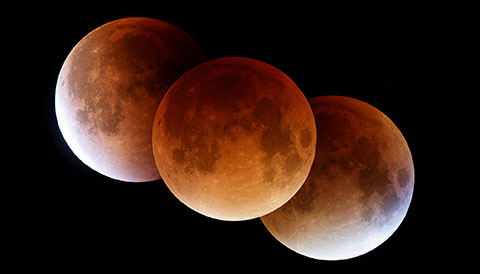
Jamie Cooper
A full 62 luxurious minutes of totality. That's what we can expect on the night of January 20–21 when the Full Wolf Moon does a slow dance through Earth's umbra (the innermost region of the shadow). The last total lunar eclipse over the Americas took place in the wee hours of January 31, 2018. This one will be more user-friendly for Western Hemisphere observers as it happens during evening hours.
If you're adept at comparing full Moon sizes, examine the Moon during the eclipse. Does it appear larger than normal? In fact it is! Perigee, when the Moon is closest to the Earth, occurs only about 14 hours after maximum eclipse. That makes this a supermoon, defined as a full Moon that comes within 90% of its closest approach to Earth. The average angular diameter of the full Moon is 31 arcminutes, but during the eclipse it will be 2.2 arcminutes wider. Let us know if you can see the difference.
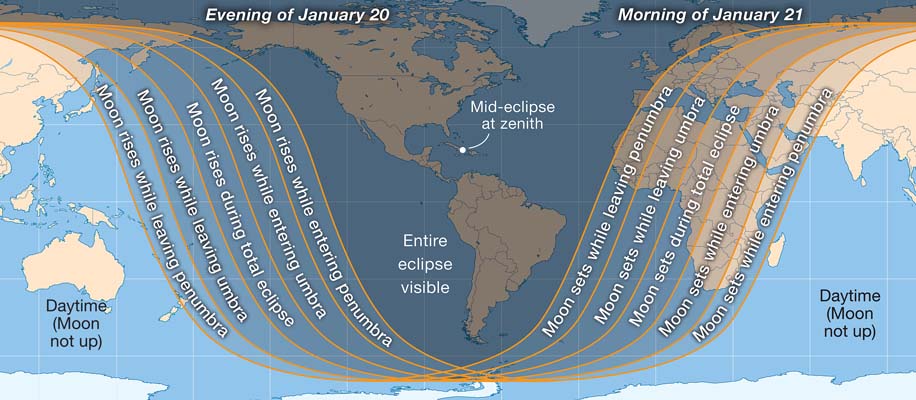
Leah Tiscione / S&T; Source: Fred Espenak
There are so many ways to enjoy a lunar eclipse. With the naked eye you can watch the Moon's stately progress into and out of Earth's shadow and its amazing transformation in color and brightness. Binoculars make eclipse colors more vivid and give great 3D views of the totally eclipsed Moon suspended among the stars. A telescope will reveal subtle colors in Earth's shadow as well as "mini-eclipses" of craters and other lunar features as the encroaching shadow covers them one after another. I plan to cut back on photography to better experience the event unhurried in real time. Reality only happens once.
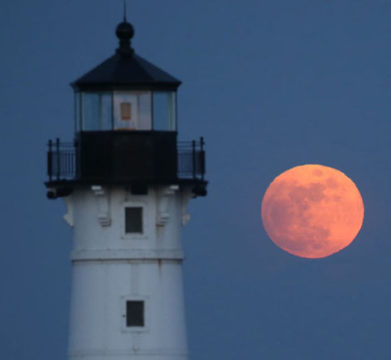
Bob King
The fun starts early during the penumbral phase, when the Moon slips into Earth's penumbra, or outer shadow. Although invisible at first, you should start to notice the penumbral shading about 20–30 minutes in, when the translucent shadow tints the lower left (celestial east) edge of the Moon a subtle gray. Look for a blunted or "dirty" appearance.
The umbra comes next, announcing its presence as a dark and ever-growing bite into the lunar cheese wheel. Test your color perception by noting how many minutes into partial eclipse you first see color in Earth's shadow.
At some point during the partial phases, take your binoculars and examine the shadow's edge. Pretty fuzzy, isn't it? Earth's shadow has a soft edge for the same reason a tree casts a fuzzy shadow. Because the Sun is an extended disk rather than a point of light, light from one side of the disk spills into areas that the other side of the Sun can't reach and vice versa. This "spillage" softens and diffuses the shadow's edge. Only point sources like Venus can create sharp-edged shadows.
While you're watching, you'll also notice that the shadow is curved, a clue ancient observers used to deduce that Earth must be spherical. Aristotle gets a lot of bad-mouthing for his geocentric universe, but he slam dunked on the Earth's shape, writing in On the Heavens:
“The earth is spherical…in eclipses the outline is always curved: and, since it is the interposition of the earth that makes the eclipse, the form of this line will be caused by the form of the earth’s surface, which is therefore spherical.”
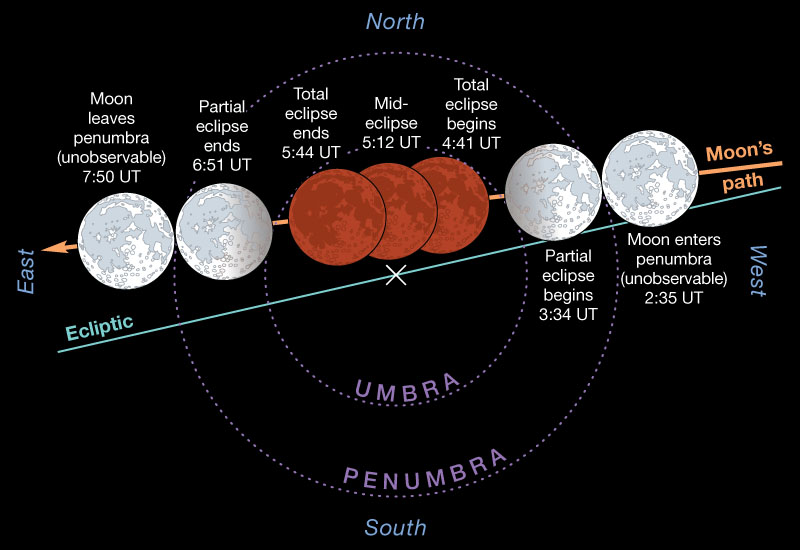
Leah Tiscione / S&T
Two minutes before totality, only the Moon's edge still lingers in sunlight (and penumbral sunlight at that!) in striking contrast to the somber and beautiful reds and oranges that tint the rest of the lunar disk. If the Earth had no atmosphere the Moon would completely disappear within its shadow. Then we might only see it with averted vision under a rural sky as a black disk silhouetted against the feeble glow of the gegenschein.
We're rescued from this dire situation by sunlight that gets refracted around the circumference of the Earth and into the planet's shadow. Because the solar rays graze Earth's limb the same way they do at sunrise and sunset, the cooler colors are scattered away by the atmosphere, leaving the warmer ones to filter in and paint the Moon in gorgeous, warm colors, the intensity of which has much to do with the state of Earth's atmosphere. If relatively free of materials like volcanic aerosols, the eclipse will be bright, but if not, the Moon can sometimes grow so dark as to be difficult to find in a light-polluted sky.
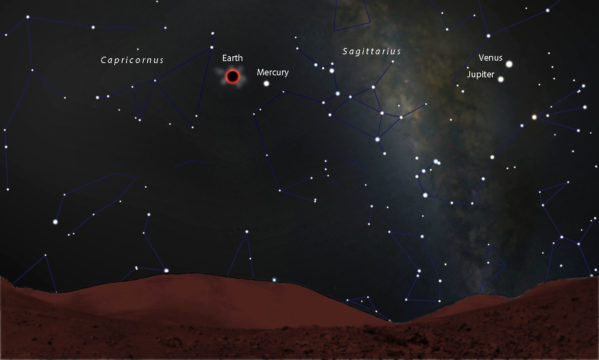
Stellarium
Take a minute during totality and pretend you're an astronaut standing on Moon looking back at Earth. The first thing you'd notice is a big drop in temperature. NASA's Lunar Reconnaissance Orbiter measured declines on the order of 250°F during the June 2011 eclipse. Now, look around and you'll see the rocks glowing smoky orange, as the vibrant red edge of Earth's blackened disk slowly covers the Sun in a total solar eclipse.
Because the Moon crosses Earth's shadow well north of umbra center, the northern limb should be relatively bright throughout totality compared to the southern. Watch for subtle changes in illumination and hue as the Moon moves through the umbra, and by all means observe the event from a dark-sky site. That way you can fully appreciate the strange quietude that spreads across the land when moonlight is fully quenched, and the stars and Milky Way return in full force.
With the Moon's brilliance quenched, telescopic observers will have a chance to see the Moon occult several stars in the constellation Cancer. For more details, go to Eberhard Riedel's Grazing Occultation Maps site.
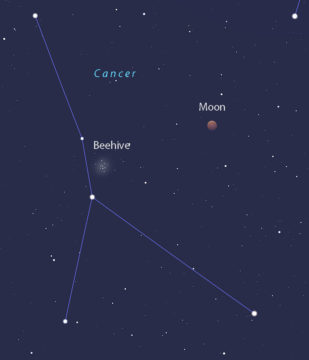
Stellarium
Fresh darkness will also reveal a fuzzy presence some 6° east of the ruddy Moon — the Beehive Cluster. Both will fit in wide-field binoculars. If you want to photograph the pair, use a 150-mm or shorter focal length, your widest lens setting, an ISO of 800-3200, and exposure of 15–30 seconds. For a complete guide to lunar eclipse photography, pay a visit to Fred Espenak's Mr. Eclipse site.
As totality ends, the lunar limb peeps back into filtered sunlight. The eclipse now runs in reverse as the Moon slowly extricates itself from Earth's shadow and stars go back into hiding.
From start to finish the whole affair will last more than 5 hours, though I doubt most of us will stay till the bitter end. One night long ago, I did. When I was finally ready for bed, I took one last look and saw a glaring, white Moon shining nearly overhead as if nothing had ever happened.
If bad weather threatens or you live in the no-eclipse zone, you can watch it via live stream at Gianluca Masi's Virtual Telescope Project, Timeanddate.com and SLOOH.

 40
40









Comments
TJW1012
January 9, 2019 at 11:51 am
I can't wait! This is going to be an awesome event!
You must be logged in to post a comment.
Bob KingPost Author
January 9, 2019 at 12:24 pm
TJW,
Agreed! I'll drive for this one if the weather looks bad.
You must be logged in to post a comment.
Rod
January 9, 2019 at 2:06 pm
Bob King, thanks for this good report and charts. I too am excited about observing this total lunar eclipse in Maryland. The Moon will be well placed in Cancer, some 70-71 degrees altitude for my location and near transit or transit time for total eclipse. I hope to use my 10-inch Newtonian with 2-inch eyepiece for wide field, lower power view (first time for a lunar eclipse) and my 90-mm refractor at 78x+ for higher magnification views, tracking the curved shadow of the Earth filling in various craters. Currently where I live we have clouds and snow showers moving through and perhaps some more this weekend. If I have clear skies and colder nights, this total lunar eclipse should be great viewing and I will post a note back here. If I do not get clear skies here, Bob enjoy the view at your place 🙂
You must be logged in to post a comment.
Bob KingPost Author
January 9, 2019 at 2:47 pm
Rod,
Thank you, and we look forward to hearing from you. Clear skies that night!
You must be logged in to post a comment.
Anthony Barreiro
January 9, 2019 at 3:55 pm
Thanks Bob. Now you've got me thinking about planning a trip out of town to watch the eclipse in a dark sky.
In the fourth paragraph you write: "The fun starts early during the penumbral phase, when the Moon slips into Earth's penumbra, ... when the translucent shadow tints the lower left (eastern) edge of the Moon a subtle gray." This would be celestial east, but lunar west.
I'm tired of just imagining what the Earth would look like from the Moon! Let's put a telescope with a video camera and a transmitter on the lunar near side, keep the telescope pointed toward Earth, and put a 24/7 live feed up on the internet. This doesn't seem like a particularly ambitious project. Maybe SpaceX will do it for us.
You must be logged in to post a comment.
Bob KingPost Author
January 9, 2019 at 5:15 pm
Hi Anthony,
Hear, hear for getting a camera on the near side of the Moon! Thanks for noting the celestial / lunar directions. I was aware of that when I wrote the article but chose not to split hairs at the time. In hindsight however, it's probably a good idea, so I'll clarify. Thanks!
You must be logged in to post a comment.
Anthony Barreiro
January 9, 2019 at 7:49 pm
Thanks Bob. I keep my hairsplitting razor sharp! 😉
You must be logged in to post a comment.
Bob KingPost Author
January 9, 2019 at 8:28 pm
Anthony,
And we like it that way here at S&T 🙂
You must be logged in to post a comment.
moonge.info
January 10, 2019 at 10:03 am
As I can see in the above picture, the most attractive observation conditions will be on the Moon 🙂
You must be logged in to post a comment.
Bob KingPost Author
January 11, 2019 at 11:32 am
Moonge,
Except for the chilly weather and lack of atmosphere, yes.
You must be logged in to post a comment.
Curt Renz
January 11, 2019 at 4:51 pm
Based on an algorithm developed by Jean Meeus, I've calculated that when the Moon exits the penumbra following the upcoming lunar eclipse, it will be the brightest Moon since 2001 and until 2096.
You must be logged in to post a comment.
Bob KingPost Author
January 12, 2019 at 2:22 am
Hi Curt,
We knew it would be brighter than normal but had no idea it would be exceptionally so. Thank you for sharing that information.
You must be logged in to post a comment.
Curt Renz
January 12, 2019 at 2:14 pm
You're welcome, Bob.
Nearness to Perigee, Perihelion and Ecliptic are the factors that will simultaneously combine to produce the extreme lunar brightness. The moments surrounding a lunar eclipse often produce the brightest Moons, since a Full Moon near the ecliptic particularly benefits from the Oppositional Flash during which lunar surface shadows are made invisible to observers.
You must be logged in to post a comment.
Bob KingPost Author
January 13, 2019 at 8:30 pm
Thank you again, Curt. All good details that can add up to a little extra sparkle. Pardon the pun, but we appreciate the extra illumination you bring to the topic!
You must be logged in to post a comment.
Mike Hanafin
January 11, 2019 at 7:09 pm
Great article and preview...I'd prefer you left out all the "full wolf moon" and super-moon nonsense, but that's just my opinion, which seems to slowly but surely be losing to the masses. At least you tried to explain the Perigee coincidence...likely to #blankstares. A lunar eclipse does not need any over-hyped nicknames.
You must be logged in to post a comment.
Bob KingPost Author
January 12, 2019 at 2:23 am
Hi Mhanafin,
Thanks! I tried not to make a big deal of it and deliberately avoided "blood" moon.
You must be logged in to post a comment.
Mike Hanafin
January 12, 2019 at 6:49 pm
I understand, and as a former news writer and web-editor I respect that sites are seeking clicks. And maybe you have to walk that tightrope. But I respectfully say that S&T does itself a disservice by going down the "supermoon" and "full wolf moon" road, which is already taken by all the non-scientific and "pseudo-news" websites, some of which are making people think they're going to see a wolf jump (bleeding) out of the Jupiter-sized moon. For an example, I normally would share your link on FB for my non-astronomer friends. But I take a stand on this, and you end up losing potential clicks. Instead, I'll just post a chart and my own version.
As an amateur astronomer I have come to S&T (as a subscriber for years...now on the newsletter list) because it has always maintained a sense of dignity by NOT playing the hype game (in fact, I can remember a few years ago when the magazine actually pointed out the over-hype and silly names--I cheered). Anyway, my opinion. I'm sure there were many other amateur astronomers wincing when they read the first few paragraphs. Respectfully, Mike.
You must be logged in to post a comment.
Bob KingPost Author
January 13, 2019 at 8:33 pm
Mike,
Clearly, those other sites have gone overboard. I do like the full moon names only for the traditional aspect they bring to the topic. But I understand your frustration with hype. Whatever way you choose to share the eclipse with friends and neighbors, I cheer you on. Clear skies!
You must be logged in to post a comment.
Rod
January 13, 2019 at 1:46 pm
Well, some interesting comments about supermoon, wolf moon, blood moon, bad moon rising, etc. 🙂 I checked the January 2019 issue of Sky & Telescope, Lunar Almanac, p. 42. Lunar angular size at apogee and perigee is given. This month, just a bit larger than 4' difference between perigee Moon and apogee Moon :). Folks using telescopes could see this subtle difference but unaided eyes, generally limited to 5' resolution. I have seen some photos showing the obvious difference when comparing the images, side by side. Hopefully, many folks will be able to enjoy this total lunar eclipse in Cancer coming soon now.
You must be logged in to post a comment.
Tom Hoffelder
January 16, 2019 at 8:29 pm
Here's my recommended test for anyone who thinks they can see a difference in apparent sizes of the moon, regardless of where it is in its orbit. Instead of holding your fist at arm's length, hold your hand there, and then "pinch" the diameter of the moon between your thumb and forefinger. Do it every time you see the moon, day or night. If you can see it, you can discern its diameter, whether it is full, a crescent or gibbous. Do it for a few months and you will be "measuring" the moon at various distances, some probably near apogee, some near perigee. Make it a double blind study by noting which ones seem smaller or larger (if you get that far after measuring it once or twice) and then compare your results to past dates of actual apogee and perigee. The amazing measurement is one taken of a full moon that is very near the horizon when it looks as big as a basketball. Because that is the "moon illusion" you will surprisingly get the same small pinch as when a full moon is overhead. That is why so many people think the super moon really is super sized, because when it is advertised in the media, everyone runs out to look at it during moon rise, and by golly if it isn't enormous.
You must be logged in to post a comment.
djswanastro
January 17, 2019 at 1:30 pm
Really looking forward to the eclipse. By the way, has anyone else got a Jan 2019 paper Sky and Telescope where the British Isles are missing on the eclipse visibility map (p19). Most strange!
You must be logged in to post a comment.
Rod
January 17, 2019 at 5:12 pm
djswanastro - yes. I checked my January 2019 Sky & Telescope issue. The British Isles are not shown on page 19. Good news, I checked using simulation software. 0500 UT in London, UK, folks should see the total lunar eclipse on 21-Jan, 0500 UT. The Moon will be in Cancer, about 25 degrees altitude and 269 degrees azimuth. The web report by Bob King does show the Brits 🙂 I am keeping an eye on the weather conditions for where I am at in Maryland. Looks like partly to mostly clear skies later with temps down near -12C for the eclipse. We are getting winter now with snow past weekend, some more later tonight, possible rain over the weekend, and quick freeze Sunday and Monday coming 🙂
You must be logged in to post a comment.
djswanastro
January 17, 2019 at 5:32 pm
Thanks, I thought I was going crazy! I'll be up at 0430 UT to witness the eclipse; the forecast ain't great though...
You must be logged in to post a comment.
Curt
January 18, 2019 at 8:56 am
First off, thanks for this fantastic article!
Second: I'm so excited, because I'm turning 60 years old on January 20th - and I was born 12 minutes before midnight - just the same time that the total eclipse is scheduled to commence. So it's like a big celestial celebration for my birthday! LOL!
You must be logged in to post a comment.
Bob KingPost Author
January 18, 2019 at 1:24 pm
Happy birthday, Curt! And what better to wish for your birthday than clear skies.
You must be logged in to post a comment.
Kathy the WI Naturalist
January 20, 2019 at 1:29 pm
About that 'Wolf Moon' label ... the only people who should be using it are members of the Mohegan tribe, or possibly other East Coast Native nations. Every tribe, or maybe even band, across North America had their own local set of month names based on cultural values and the progression of the natural year in their area. Here in Wisconsin, the two tribal names I happen to know about are the Ho-Chunk 'First Bear Moon', because in their dens sow bears are giving birth, and Anishinabe (Ojibwe) 'Big Spirit Moon'. The whole point of these names is that they are local and non-standardized. To imply that this is the 'Wolf Moon' all over North America is to lump the Native nations together in a disrespectful and unacceptable way. Please be aware of this. Of course, the GOOD news is that lots of people are interested in what's going on in the sky! Thanks for all you do to encourage this.
You must be logged in to post a comment.
Bob KingPost Author
January 21, 2019 at 9:16 pm
Thanks, Kathy for your comment. No disrespect intended. I understand the issue with full moon names — there are SO many! I went with the Farmer's Almanac choice as did many other magazine, newspaper and media outlets. I did this because that term has been in more general use than the First Bear Moon at least in part because of the Farmer's Almanac. I have to say though that being from Minnesota and living just 6 miles from Wisconsin, I like that name equally well.
You must be logged in to post a comment.
mary beth
January 22, 2019 at 10:39 pm
Here’s a neat link I found about various moon names...my January favorite is the Kalapuya tribe’s - “Atalka” which means ‘stay inside’ !
You must be logged in to post a comment.
mary beth
January 22, 2019 at 10:39 pm
https://www.wwu.edu/skywise/indianmoons.html
You must be logged in to post a comment.
Tom-Reiland
January 21, 2019 at 12:08 am
I watched the Eclipse on and off from first contact of the Umbra on the Moon until a few minutes after totality. Can't see anything now with cloudy conditions and gnat-like snow. I'm glad that we made the right decision to cancel the Eclipse Party at Wagman Observatory because of cold temps, severe windchill and other factors. It saved a lot of gas, frostbite and aggravation. Not certain how many Lunar Eclipses this is for me. At least 10 to 12.
You must be logged in to post a comment.
Rod
January 21, 2019 at 2:34 am
Bob King et al. I did enjoy this total lunar eclipse tonight - it was great! Very cold, temp -10C with winds 320/20 knots gusting to 30 knots at times. There was some cirrus interference before 2315 EST (0415 UT) but clear after that. Observed 2200-0130 EST. I enjoyed the total lunar eclipse tonight in Cancer. I used 90-mm refractor with 14-mm Delos. Great views at 71x and 1 degree true FoV. Published entry times for craters like Grimaldi, Aristarchus, Tycho, and Copernicus looked good when I checked my cell phone time (Joe Rao report in Jan issue of S&T). The Earth's shadow when partial eclipse began (2234 EST) covered these craters as the eclipse event continued so I checked the times. Middle of totality tonight was 21-Jan-19 at 0012 EST. I continued to watch until Tycho crater emerged or exited from Earth's shadow during partial eclipse ending period. Tycho crater exit time, Aristarchus exit time, Grimaldi exit time, and Copernicus exit time - looked accurate based upon my cell phone time. Very dramatic viewing the curvature of the Earth's shadow covering the Moon and then the Moon moving away with the shadow uncovering the lunar surface as the Moon departed Earth's shadow. I observed one meteor flash by south of the Moon near mid-eclipse. 0008 EST (0508 UT), about 2nd magnitude moving towards Leo. M44 open cluster easy to see along with other stars and constellations like Sirius in Canis Major, Orion. At mid-eclipse or 0012 EST (0512 UT), the Moon was 71 degrees altitude and 175 degrees azimuth for my location while viewing. Orange color around Tycho crater and other areas during this eclipse. At middle of totality, I would rank 2.5 or 3 on the Danjon scale (Joe Rao report in Jan S&T). The star, TYCH1385-361-1, mv +9.62 in Cancer near the Moon, was occulted by the Moon near 2350 EST as I viewed. I could see this at 71x as I observed the lunar eclipse. The telescope view showed a circular shadow when the Moon entered and exited Umbra tonight. Very dramatic views at 71x and 1 degree true field of view.
You must be logged in to post a comment.
Bob KingPost Author
January 21, 2019 at 9:12 pm
Hi Rod,
I liked how the lunar highlands around Tycho looked so "washed out." A pale orange compared to the rich, darker maria.
You must be logged in to post a comment.
Rod
January 21, 2019 at 10:20 pm
Bob King, so correct about viewing the area around Tycho crater during the eclipse. The total lunar eclipse lasted 62-63 minutes, ending 0044 EST/0544 UT. The total lunar eclipse started 2341 EST/0441 UT. I continued to watch until Tycho crater emerged or exited from Earth's shadow (0627 UT/0127 EST). I really enjoyed seeing the Earth's curved shadow covering up the craters and then later, moving away from them as the Moon orbited some 2200+ mph traveling through the Umbra, the lunar landscapes came back into full sunlight as that very large circular shadow went zipping by. I felt like I was in a spaceship approaching the Moon while viewing all of this 🙂 However, it was brutal cold and windy too (I am sure the same for you too). I was very glad for the wood burning stove with quick breaks for thawing out, only to venture back out and wrestle with winter 🙂
You must be logged in to post a comment.
Mike Hanafin
January 21, 2019 at 2:41 am
Watched the lunar eclipse from start of partial phase to the end of totality + 10 minutes of the final partial phase, in crystal clear skies before some thin clouds moved in around 10 pm. So fortunate to get clear skies in January in Vancouver! I've probably seen 20 lunar eclipses in my (ahem, long) lifetime, and this was one of--if not the--brightest I've ever seen. I am interested to see more Danjon Scale estimates from more experienced and knowledgeable astronomers , but I would call this a 3.5. Far more orange than red, but quite bright...easy to see the entire eclipsed disc with the naked eye--even during the partial phase. Variable shading and brightness--as usual--near the outside edge of the Earth's shadow. It was spectacular, and not a wolf, or blood in sight. 😉
You must be logged in to post a comment.
Rod
January 21, 2019 at 9:02 am
Mhanafin, I like your Danjon Scale estimate, 3.5. I was hovering around 3.0 while I thought about it near middle of totality. I viewed from Maryland along the Patuxent River Valley Farms and park areas. The star I observed occulted is TYC1385-361-1 or HD 68121 on SIMBAD portal. Stellar parallax indicates it is about 859 LY away. The color was more orange in various areas too as you describe during the lunar eclipse.
You must be logged in to post a comment.
Bob KingPost Author
January 21, 2019 at 9:11 pm
Mhanafin,
We appreciate the time to share your Danjon estimate. Thank you!
You must be logged in to post a comment.
Anthony Barreiro
January 21, 2019 at 7:15 pm
San Francisco was forecast to be mostly cloudy, with high winds, showers likely, and possibly a thunderstorm. I stayed home with no expectations, but kept an eye out the window and went outside when conditions warranted. Between rain squalls and through dramatic clouds I was able to see the first ten minutes of the first partial phase, a few tantalizing brief glimpses of totality, and most of the second partial phase. It was more than enough to satisfy my umbraphilia. I love watching the Moon move through the edge of Earth's shadow -- you can see in real time how fast the Moon is orbiting the Earth.
When I got up and went outside before dawn this morning the sky was perfectly clear and the full Moon was shining innocently in the west, acting as if nothing special had happened a few hours earlier.
You must be logged in to post a comment.
Bob KingPost Author
January 21, 2019 at 9:10 pm
Anthony,
I love that innocent look! Glad it was clear for you.
You must be logged in to post a comment.
Anthony Barreiro
January 24, 2019 at 3:11 pm
I would have preferred clear weather a few hours earlier! But we have to make the best of what we get.
You must be logged in to post a comment.
Rod
January 23, 2019 at 9:24 am
mary beth, thanks for the moon names info. I used a 90-mm refractor with 14-mm Delos eyepiece. The view was about 71x with just about 1-degree true field of view in the eyepiece - breath taking. I share this note from my stargazing log because I see so many videos on YouTube promoting an alternative view of lunar eclipses (I received some more this morning in my inbox). "Note - Joe Rao report in January 2019 Sky & Telescope showed Tycho cratered entered Earth's shadow at 0356 UT or 2256 EST. I observed this using my telescope shortly after partial lunar eclipse began at 2234 EST or 0334 UT. Joe Rao report shows Tycho crater exit Earth's shadow at 0627 UT or 0127 EST. I observed this too using my telescope. The crater entrance and exit times for this lunar eclipse looked accurate as published on page 20 for the report. Using the telescope - we clearly are viewing a very large circular shadow, much larger than the Full Moon diameter that the Moon is moving through causing the total lunar eclipse. The Earth's circular shadow with the Sun shinning on the opposite of the planet - confirms we live on a large, round planet that the Moon is orbiting."
You must be logged in to post a comment.
You must be logged in to post a comment.